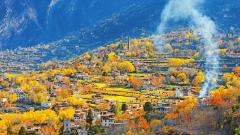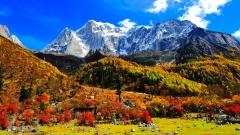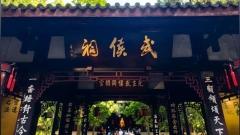Chengdu is a city of contrasts: modern skyscrapers meet tranquil teahouses, spicy street food sits beside centuries-old courtyard homes, and laid-back locals stroll past lively bars. At the heart of this balance sits one of Chengdu’s most atmospheric destinations – Kuan Zhai Xiangzi, commonly translated as the Wide and Narrow Alley (or Wide & Narrow Alley). This restored Qing-dynasty neighborhood of three parallel lanes – Kuan Alley (Wide Alley), Zhai Alley (Narrow Alley) and Jing Alley (Well Alley) — offers a compact but rich window into Sichuan life.
History and Origins of Kuan and Zhai Alley
Kuan and Zhai Alley began as part of Chengdu’s urban fabric during the Qing Dynasty. Originally built as residential lanes with classic siheyuan (courtyard homes), the area later accommodated military officers and city administrators. Over centuries the alleys mirrored Chengdu’s development: from quiet neighborhood to a bustling community hub, then to a threatened historic district, and finally to a revitalized cultural quarter.
The restoration effort focused on preserving traditional architectural features — wooden eaves, grey-tiled roofs, carved doors and intimate courtyards — while retrofitting buildings for contemporary uses like teahouses, boutique shops, and restaurants. The result is a place where historical ambiance is tangible: every doorway, carved window and narrow lane hints at an older Chengdu, even as the neighborhood hums with 21st-century life.
The three parallel alleys offer different vibes that complement each other:
- Kuan Alley (Wide Alley) is open, social and snack-filled — think teahouses, local specialties and people-watching.
- Zhai Alley (Narrow Alley) is quieter, courtyard-focused and perfect for lingering in a boutique guesthouse or folk restaurant.
- Jing Alley (Well Alley) is the modern, nightlife-focused strip where bars and late-night venues keep the area lively after dark.
In short: daytime brings tea, snacks and shopping; evening brings lights, music and a youthful crowd. The compact layout is walkable, so you can experience each alley in a single visit.
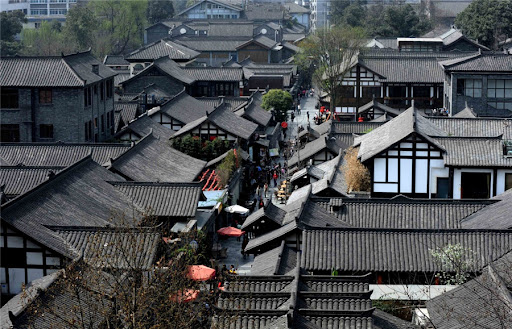
Wide and Narrow Alley
Kuan Alley (Wide Alley)
Kuan Alley earns its name with broad walkways and open courtyards. It’s the alley where the slow, convivial pace of Chengdu life is most visible.
What to see and do
- Sip tea in a traditional teahouse and watch locals play mahjong or chat for hours.
- Sample Chengdu street snacks from stalls and small vendors — perfect for trying Dan Dan noodles, liang gao or crispy spring rolls without committing to a full meal.
- Browse handicraft stores showcasing Sichuan embroidery, bamboo crafts, and lacquerware.
- Enter a preserved siheyuan (courtyard home) if one is open to the public — these give a sense of how family life was organized around central courtyards.
Why Kuan Alley stands out
Kuan Alley blends community ritual (tea and leisure) with artisan commerce. It’s where you’ll see the contrast between restored historical forms and modern use — cafes inside old gates, handcrafted souvenirs sold beside modern design items.
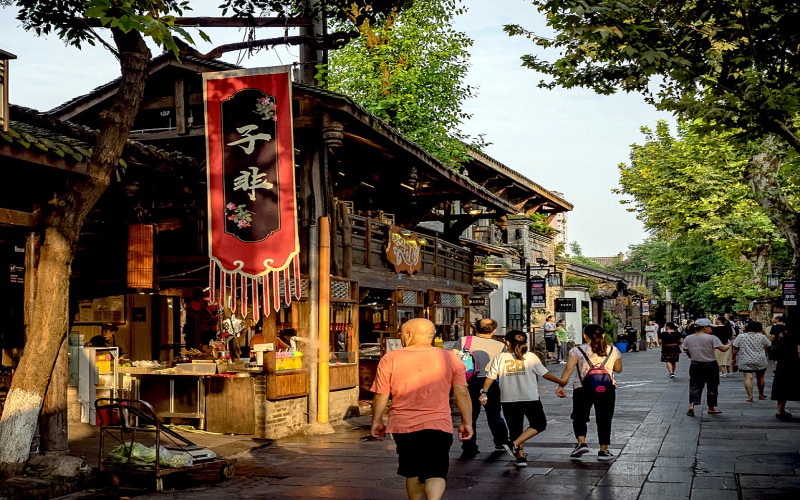
Wide Alley
Zhai Alley (Narrow Alley)
Zhai Alley is the intimate, contemplative counterpart. Its name suggests narrowness, but what it truly offers is a quieter sense of place.
What to see and do
- Walk through restored courtyards now hosting themed guesthouses, boutique cafes and small museums.
- Take time in folk restaurants to taste home-style Sichuan dishes prepared with regional flair.
- Explore the culture wall — a lengthy mural or installation that tells Chengdu’s story through imagery, inscriptions and art (a great backdrop for photos).
- Discover artisan stalls where sugar figurine-makers, calligraphers and painters create on the spot.
Why Zhai Alley stands out
If you want a slower, more immersive experience — to sit in a courtyard and absorb details like carved beams and tiled eaves — Zhai Alley is the place. It’s often quieter and better suited to travelers who appreciate architecture, craft and slow dining.
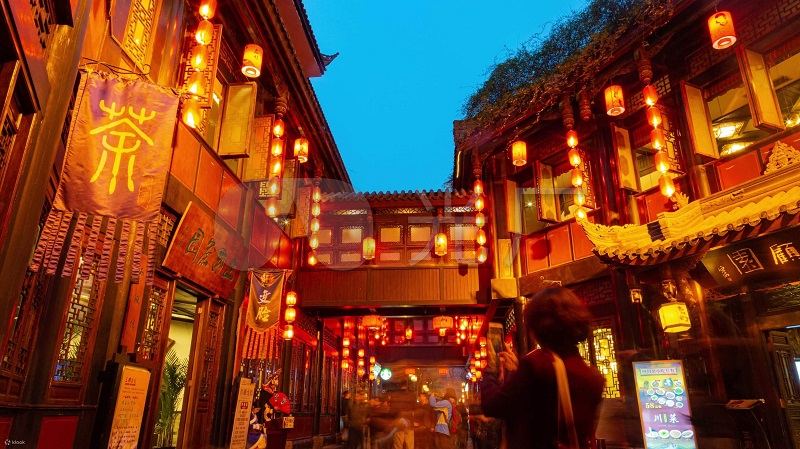
Wide and Narrow Alley at Night
Jing Alley (Well Alley)
Jing Alley plays the role of the neighborhood’s night pulse. Once built around communal wells that sustained daily life, today Jing Alley channels that social energy into nightlife.
What to see and do
- Enjoy an evening drink in a bar set inside traditional architecture: modern interiors alongside classic façades.
- Catch live music, small-scale performances or themed nights at boutique venues.
- Sample Sichuan fusion dishes and late-night snacks that pair well with local craft beers.
Why Jing Alley stands out
Jing Alley bridges old and new: the well symbolizes community life, and now the alley’s bars and night inns keep that communal spirit alive after sunset. It’s the alley to pick when you want to experience Chengdu after dark.
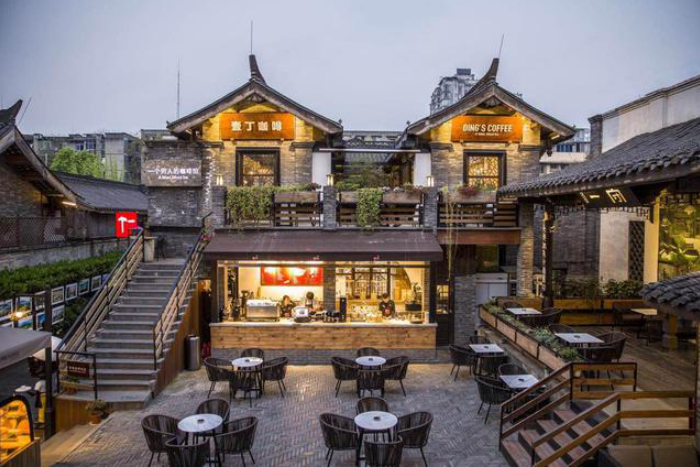
Jing Alley
Attractions and Activities in the Wide and Narrow Alley
The Wide and Narrow Alley complex is compact but packed with activities. Here are highlights to plan around:
Cultural Performances
Sichuan opera snippets and folk music performances occur regularly; look for venues advertising short evening shows with the region’s signature “face-changing” acts. These performances are short, colorful and highly photogenic — a great introduction to Sichuan performing arts.
Artisan Demonstrations
Street artisans often demonstrate age-old crafts — sugar figurines sculpted by hand, wood carving, bamboo weaving and calligraphy. Watching a craftsperson at work is both entertaining and educational; purchases also support traditional skills.
Courtyard Experiences
Book a tea ceremony or short cultural workshop held in restored siheyuan. These sessions often cover tea tasting, basic calligraphy, or a quick introduction to Sichuan folk culture.
Photography
The alleys are a photographer’s dream: layered doorways, reflective puddles, old tiles and the play of natural light in narrow lanes. Early morning or just after sunset offer the best quality light and fewer crowds.
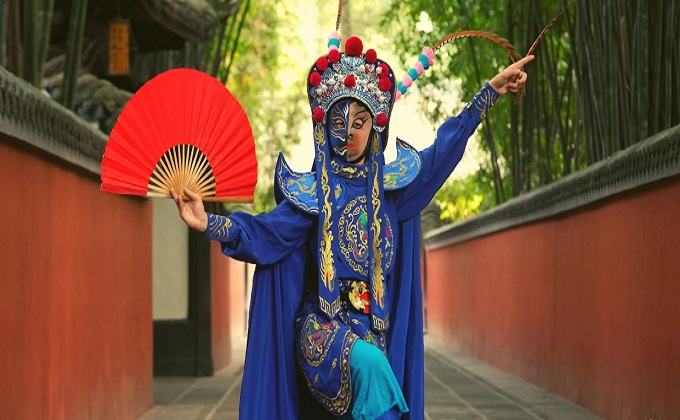
Sichuan Opera
Dining: Must-Try Foods and Where to Find Them
Chengdu cuisine is famous for bold flavors and numbing spice — and the alleys are a great sampling ground.
Local snacks to try
- Dan Dan Noodles: A street-level staple — spicy, nutty and comforting.
- Sichuan Hotpot (in nearby restaurants): If you’re brave, splurge on a hotpot experience; many alley eateries offer a milder version for tourists.
- Liang Gao and Chun Juan: Sweet and savory snacks to nibble as you stroll.
Dining tips
- Try small plates at folk restaurants in Zhai Alley for a more intimate tasting experience.
- If you have a lower spice tolerance, ask for “less spicy” (qing dan or shao la) — vendors can often adjust levels.
- Pair snacks with tea in Kuan Alley’s teahouses for a balanced, local rhythm.
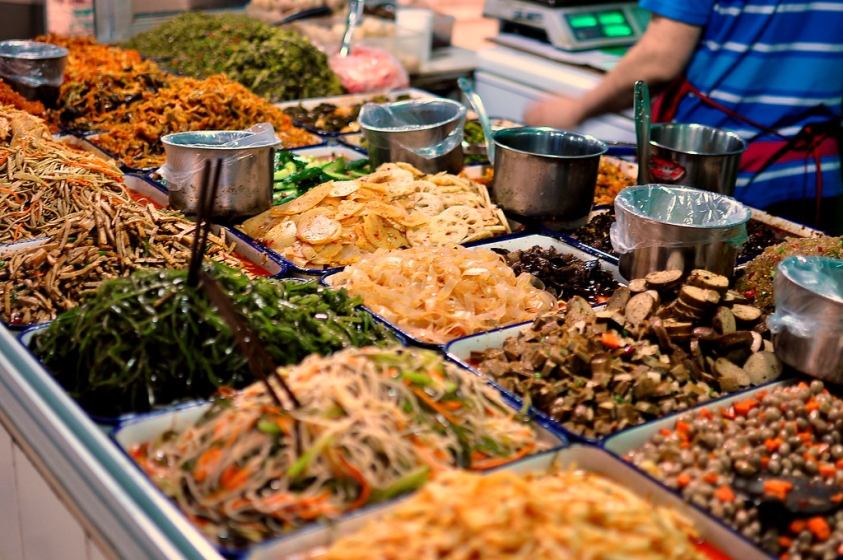
Street Food Chengdu
Shopping: What to Buy and Where
The alley market is perfect for authentic, easy-to-carry souvenirs.
Best buys
- Sichuan embroidery: Bright, intricate and easy to pack.
- Bamboo crafts and lacquerware: Useful souvenirs that reflect local techniques.
- Panda-themed keepsakes: Cute and popular, though look for higher-quality items beyond generic trinkets.
- Local spices and sauces: Sichuan pepper, chili pastes and tea blends travel well and are useful gifts.
Shopping tips
- Bargaining is possible but polite bargaining: start about 10–20% lower and be friendly.
- Look for studios or certified craft shops if you want guaranteed quality and fair prices for artisan pieces.
- Many shops accept mobile payments — cash or international cards may be less common, so carrying some RMB is wise.
Practical Information for Travelers
Opening hours & entry
- There is no entry fee to walk the alleys; individual shops and cultural sites have their own opening hours (typically 10:00–22:00).
- The area is accessible 24/7 for wandering, but daytime and evening operations vary.
Getting there
- People’s Park metro station or a short taxi ride will put you nearby. Chengdu’s metro and taxis are efficient; for convenience, show drivers the Chinese characters: 宽窄巷子 (Kuan Zhai Xiangzi).
Crowds & timing
- Weekdays and early mornings are the calmest. Evenings and weekends are busiest, especially around holidays.
- If you want photos without crowds, aim for sunrise or an early weekday morning.
Accessibility
- The alleys are primarily pedestrian and paved with traditional flagstones; mobility can be uneven in places. Travelers with mobility concerns should identify accessible routes beforehand and allow extra time.
Tips for International Visitors
- Language: Basic Mandarin phrases help, but many vendors cater to foreign visitors. Carry a translation card or app for fixed-address details.
- Cash & payments: Mobile payments are common in China; ensure you have local currency or a payment method accepted by vendors.
- Heat & spice: Sichuan cuisine is famously spicy. If in doubt, ask for milder preparations.
- Respect the space: These are living, restored neighborhoods; treat them kindly to help preserve their character.
Photography and Cultural Etiquette
Photography tips
- Capture courtyards, doorframes and artisans at work for unique shots.
- Respect performances — ask before photographing performers or private courtyards.
- Use a wide-angle lens for narrow lanes and a mid-telephoto for candid street portraits.
Local etiquette
- Be polite when entering shops or teahouses; a simple greeting goes a long way.
- When sampling food, avoid wasting; small portions or shared plates are common.
- Ask permission before photographing people, especially elders or performers.
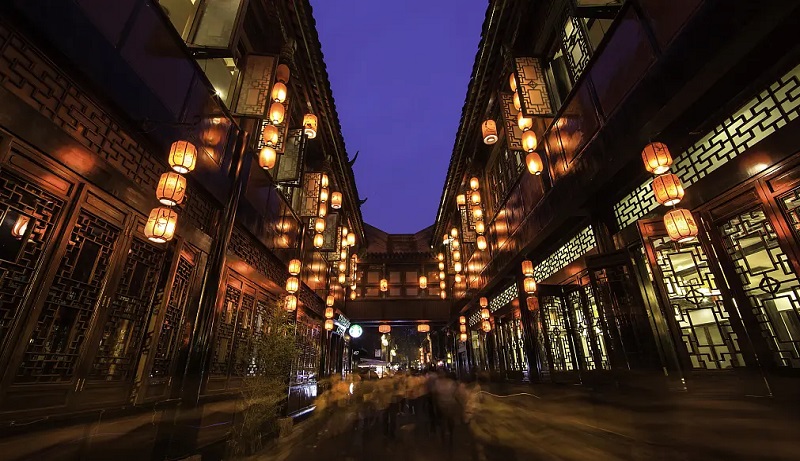
Kuan Alley and Zhai Alley
Sample One-Day Itineraries
Morning — Local life and breakfast
Start with a relaxed breakfast of Dan Dan noodles at a Kuan Alley stall. Sip tea in a teahouse and watch locals begin their day.
Midday — Courtyards and crafts
Move to Zhai Alley for courtyard visits and artisan demonstrations. Have lunch at a folk restaurant, sampling regional dishes.
Afternoon — Shopping and museum stops
Browse handicraft shops, pick up spices and embroidery, and savor a late-afternoon tea. Step into small exhibitions or themed houses for a cultural snapshot.
Evening — Nightlife in Jing Alley
Dine near Jing Alley, then hop between bars or catch a short Sichuan opera performance. Finish with a nighttime walk to appreciate the alleys’ illuminated architecture.
Why Kuan and Zhai Alley Matter
Kuan and Zhai Alley is more than a tourist attraction: it’s a living neighborhood where Chengdu’s past meets its present. In a single stroll you can sip tea in an ancient courtyard, watch an artisan at work, taste some of China’s most exciting regional food, and end the night in a modern bar pulsing with local creativity. For international visitors, the alleys serve as an accessible introduction to Sichuan culture — human-scaled, sensory, and layered with stories.
If you’re planning a deeper Chengdu itinerary, treat the Wide and Narrow Alley as your cultural starting point: explore its lanes slowly, sample widely, and then venture outward to People’s Park, the panda reserves, and the city’s many temples and markets.
For travelers who want help turning this visit into a seamless experience – arranging a curated food crawl, a private courtyard tea ceremony, or a guided walking tour in English – China Dragon Travel offers tailored Chengdu itineraries that include Kuan Zhai Xiangzi as a highlight. Local guides can unlock hidden courtyards, recommend the best spots for authentic snacks, and make practical arrangements so you can focus on soaking up the atmosphere.




